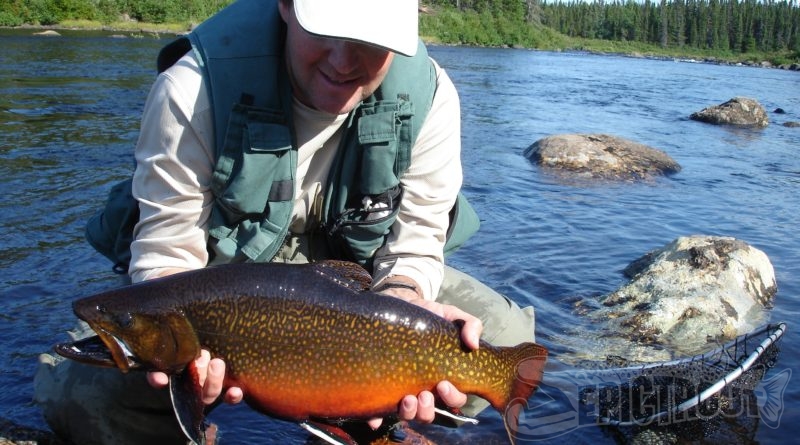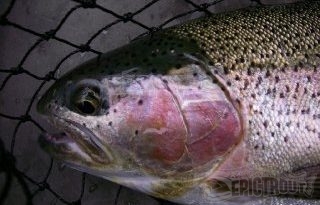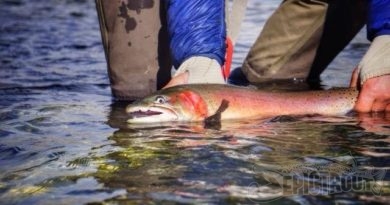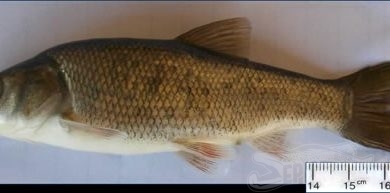Big Trout Goals!
Growing up in the Rocky Mountains of Colorado, trout were the only option for anyone who fished. I was no exception and I remember the day my dad brought home my first fishing rod. I was four or five years old I had tears of joy because I knew that I would get to go fishing with my dad. That first trip was incredible and I remember catching my first stocker rainbow trout. It was my first real trout I could not believe its colors and markings. Even at such a young age, I found trout fascinating in how they could live in such cold water. What a mysterious environment they come from, I thought. Little did I know that this would evolve into a life long passion I hope to carry until the last day I walk this earth.
A few years later I was at the local hardware store with my father. One of the local customers brought in a big rainbow trout he had caught and had mounted. I could not believe my eyes. I had gotten used to catching stocker trout and had no idea a trout could grow to this size. This big fish was probably five or six pounds and it was by far the biggest trout I had ever seen. It as at that point that I knew I wanted to catch a big trout, but it would take me decades to realize success.
Some nine or ten years later, a local lake would become my focus for a big trout. Twin Lakes, Colorado was known to produce a few big lake trout each year, with the threshold for “big” being10-pounds. I began this “trophy quest” to break this 10-pound barrier in when I received my driver’s license. It allowed me to fish more and find a few “good” spots, and I also learned some techniques were better than others for catching lakers. It was also the time that I decided I would begin to write down notes of each fishing trip, a journal of sorts. Some thirty-five years later, I continue to do this and it has been one of my most important assets to catching behemoth trout.
In those days, most of my fishing was short outings, a few hours after school, or a weekend day. I wrote down everything I could about the trip: number and type of trout caught, where I fished, water conditions, water depth, weather conditions, and any observations that I might have seen. I also included such things as discussions with other anglers, especially if they caught fish. I would try my best to remember these conversations and try to extract any worthy information, hoping that it would be useful to solve that utterly complex formulation to catch a giant trout.
It was also at this time, when I decided to write down a set of goals related to landing giant trout of the different species. My goals were based on my limited knowledge of big fish and the resources I could find on this topic of trophy fishing. My world was limited, restricted to the few fishing magazines that were available (namely Outdoor life, Sports Afield, and Field and Stream). There was one fishing program at that time, a show hosted by Jerry McGinnis, the Fishing Hole. I learned a lot about big fish back then, even though there were only a few episodes dedicated to big trout. But that was the limit of my big trout knowledge at that time. Back then, I remember it would take all my savings to buy these few magazines, so I mostly got used copies from my father’s friends. There was no Internet available, and I was pretty much isolated within my small mountain town of Leadville. Back then, my goals were pretty constrained, as was my thinking.
Looking back at both my professional and fishing career, I have found incredible value about writing down goals. They put the stake in the sand and provide the basis for the focus and effort required if they are to be realized. With any goal, I have two rules: First the goal must be possible. It simply has to be possible from a scientific and economical perspective. Such a goal can literally take a lifetime to achieve and so they are stated as such. The second rule is that there must be an intermediate goal, a stepping-stone to achieve that lifetime best. This was important to remain engaged with the focus, dedication, learning and ultimately the application of these learning’s. In another words, the intermediate goals generate the valuable experience that will ultimately be needed to achieve the lifetime goals. They also will validate if one has the passion to pursue those lofty lifetime goals. The first set of goals that I ever remember documenting were related to giant trout!
The table below includes my initial and lifetime goals back in 1977. Back then, it was rare to see a trout over 10 pounds, with the exception of a lake trout. Once or twice a year some “lucky” angler would catch a lake trout between 10 and 20 pounds and it made the local newspaper. For other species of trout, a 5-pound fish was a true trophy.
| Type of Trout/Char | Goal within 5-years (in 1977) | Lifetime Goal (back in 1977) | Current Lifetime Best (2016) | New Lifetime Goals |
| Lake Trout | 10-pounds | 20-pounds | 42-pounds | 50-pounds |
| Rainbow Trout | 7-pounds | 10-pounds | 37-pounds | 40-pounds or 25 over 20 pounds |
| Cutthroat Trout | 5-pounds | 10-pounds | 15-pounds | 20-pounds |
| Brown Trout | 7-pounds | 10-pounds | 23-pounds | 30-pounds or 5 over 20 pounds |
| Brook Trout | 3-pounds | 5-pounds | 8.5-pounds | 10-pounds |
| Arctic Char | Not realistic | 10-pounds | 23-pounds | 30-pounds |
In reviewing my journal of more than thirty-five years, it would take me until 1984 for me to see my first 10-pound plus lake trout. The “monster” was a 17-pounds, and caught from my dedicated fishing hole, Twin Lakes, while trolling a giant flatfish. Up to that day, I logged more than 1000 hours of lake trout fishing! It was not until 1989, at the completion of college, that I finally broke the 20-pound barrier for lake trout, a beautiful fish from Lac La Marte, a gigantic lake in Canada’s Northwest Territories. The 5-year goals for rainbow, cutthroat, brown and brook trout realized, but it would be10 and 35 years to realize the completion of those original lifetime goals.
My brown trout lifetime goals were realized in the mid-1980’s when a local newly formed lake, Spinney Mountain Reservoir opened. Like many new lakes, this lake commonly grew trout to 10-pound plus sizes in only 3 to 4 years. This was the “hot” lake to fish for trophies for many years. However, in recent years, it has been on the decline due to numerous factors including whirling disease, sucker competition, pike predation, and fishing pressure. After this was realized, I raised the bar for a 15 and eventually a 20-pound brown. Both were realized with a 21-pound brown from a Lake Ontario tributary and a 23-pound female brown from the Rio Grande River in Terra del Fuego, Argentina. The second fish was my only brown over 5 pounds on that big trip way far away!
One of two 20-pound brown trout. This one, from Tierra del Fuego was 23-pounds, was the biggest of the season from that lodge!
My Brook trout Lifetime goal was realized in 2000 on the Minipi River, Labrador and I have been fortunate to return to this lake many more times to continue to my trophy quest for my favorite or all trout species. I have also taken many brook trout in the 3-6 pound range in local waters and these fish taught me just how fragile a trophy lake could be. Once word was out on one of these lakes, it was decimated within a few weeks. It was one of the saddest times of my entire trophy quest.
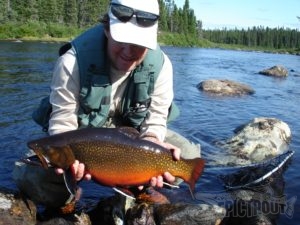
Probably my prettiest trout ever, a 7 pound male brook trout from Minipi!
My rainbow goal was realized from the Quinault River in Washington in the early 2000’s. Since then, I have for some reason, caught numerous big rainbows, from many different waters, including a couple of catches over 30 pounds in Canada, Argentina, Colorado waters, and the great lakes. The rainbow is the most popular of all trout, so that may be the simple explanation so many opportunities for big fish of this species.
My best trout catch ever, a 37-pound rainbow!
I caught my first 10-pound char back in the late 1980’s on my first big trip to inside the Arctic Circle. Back when I wrote my initial set of goals, this was the one fish that was not found locally, but I had read about it in some of the old magazines and I could not believe any trout (or char) could have such colors. But it would be 25 more years before I would break the 20-pound barrier, which became my new lifetime goal after I landed my first 10-pound plus char.
This trophy took the longest, more than 25 years to achieve. This was a 23-pound arctic char in full spawn colors!
The cutthroat trout was the most difficult of all goals to be realized. This was reached a couple of years ago at Pyramid Lake, a huge inland lake that I had fished off and on since the 1990’s. On that fateful trip in 2014, I was fortunate to capture 3 fish over ten pounds on a 3 day trip. In all my trips combined (about 60-days total), my biggest was an 8-pound cutthroat. Now have a new lifetime goal to capture a cutthroat trout over 20-poounds. I never thought this was even remotely possible until Pyramid Lake made what I believe is the best recovery of any big trout lake, ever! Those ichthyologists, fishery biologists and anglers who put this puzzle back together for such a comeback deserve huge recognition for their work. I just hope that there is longevity in seeing these give fish into the distant future!
15-pound cutthroat from Pyramid Lake. The fish struck at high noon on calm water. Everyone had left for the day and then the fishing got good!
I have given presentations on the “how to catch trophy trout” many times and people always ask me what is that secret formula to my success. I have pondered this over the years, reflecting back and they are often disappointed that there is no magic potion at all, but rather dedication. Over the years, I have been able to boil this success down to few of key points.
- o Passion – I have the passion to capture, photograph, and release big trout. This is part of my soul. I think about big trout every day, and probably every waking hour. I constantly scour the Internet and any available literature of behemoth trout places.
- o Go to the Big Trout Spots – The number one rule to catching a big trout is to go where they are found. For the biggest in the world, this can require significant research and travel. This can require other resources and goals to overcome the economic challenges in order to visit these spots.
- o Understand the species and its environment. There is a huge knowledge base on trout fishery science that is at our fingertips. The more one knows, the better one will understand trout and their environment. This goes beyond the macrocosm of book learning and is why those journal notes can often bridge the gap between the book knowledge and the actual opportunity to cast to a giant fish. Within every lake is a unique microcosm. Once the microcosm is understood, one will find the path to the big fish within that system. A simple example is lake trout. They are known as a deepwater fish and they like to be near geological structures (ledges, underwater humps) where they can ambush prey, but also where they can feel safe. Knowing those spots in a given lake will be one of the keys to big lake trout in that lake.
- o Practice catching big fish – this might not make sense at first, but the more big fish one catches, the more one expects to catch big fish. With each fish, comes experience on what it took to find, hook, and land that trophy. Experience calms one’s nerves and allows one to clearly think under those exciting times when the big fish is on the line, but not quite captured! I cannot count the number of big fish others have lost simply because they got too excited at “the moment of truth”. They lose track of common sense, and lose their trophy.
- o Optimize your time – Plan, plan, and plan each and every trip. Our greatest and most valuable asset we have is time. When it applies to big fish, especially when one travels to a big fish spot, every minute counts. Plan with good gear, how to use the gear, and have a plan for the water. Always be willing to modify the plan if conditions require a change. This can be through a change of tackle, moving to a new spot, or trying different techniques.
- o Be confident – As I mentioned above, trophy trout are often caught by the same people over and over again. This is because they have the expectation of catching big fish and simply put, they do. I do not know of anyone who has caught a giant trout and then gave up fishing. We always come back for more!
- o Be part of big fish organizations. I am a long time member of the International Game Fish Organization (IGFA) and memberships bring a never-ending string of possibilities where to find giant fish. There are other organizations such as the National Fresh Water Fishing Hall of Fame, and several big fish web sites, such as Epictrout.com that can help narrow the search for the biggest fish in the world.
- o Learn to fly fish. Like it or not, many of the best places for big trout are fly fishing only. There are several fishing travel businesses such as fishingwithlarry.com, that offer incredible opportunities for big trout. What one will find, however is most of them are fly fishing only. If fly-fishing provides the keys to the kingdom, then that is what one must do.
- o When it makes sense, invest in a local guide. This is very valuable approach to learning new water, especially if it is one that will be repeatedly fished.
Notice I used the word “invest” when it comes to a local guide. Earlier, I mentioned that my first big lake trout took more than 1000 hours to catch. This was on a local lake that I could fish nearly every day and it was literally a trial and error learning experience. If I added all the associated costs just to travel back and forth to the lake, it cost me on the order of 5 to 10K, and that was in 1970 dollars. A few years later, I wanted to start fishing Flaming Gorge. I had expressed my intent with someone who had fished the lake before and he gave me a name of a new guide that had a reputation for catching big lake trout on light tackle. (Light tackle was exactly how I wanted to fish for giant trout!) He was just starting out his business and I managed to convince him to guide me on the lake for three days at a hundred dollars per day. In those days, $300 dollars was a huge amount of money to tack onto the cost of a big fishing trip!
At first, it was hard to swallow my pride and pay the money, but by the end of the first day, I had landed three lake trout over 20 pounds, with my biggest at 28. The guide was very good at explaining his techniques and we fished more than a dozen different spots on the lake. Considering that Flaming Gorge is more than 85 miles long and has a thousand miles of shoreline, it could have taken me years and years to find what I found that first day. At the end each day, I sat down and wrote down every detail I could remember from the day of fishing. I was then able to apply this knowledge to my existing body of knowledge and it was a huge leap forward in my ability to catch trophy lake trout (and other species). Since that first trip, I have fished the Gorge on my own, building on foundational knowledge learned from that very first trip. I have landed over a hundred 20-pound lake trout, a couple dozen fish over 30-pounds, and three big fish over 40 pounds, all from Flaming Gorge. It was the best investment I ever made in trophy fishing.
Like all investments, I always check the guide’s validity. I will always talk to them a couple of times and will request references. I want to make sure I know what to expect from my guide and I also want to know what my guide will expect from me in order to maximize success for both sides.
In today’s strong practice of capture, photograph and release fishing, I firmly believe that fishing for truly giant trout is better than ever. From a genetics perspective, the gene pools of these giants continue to improve and the majority of anglers and scientists are working harder than ever to preserve them. We have more tools at our fingertips than ever thought possible to track down those big trout spots around the globe. Tackle is better, techniques continue to improve and world records are consistently being set and reset. To make it all work, we need to have that set of goals that provides the glue and focus to put it all together. When you have success, and the big fish is in your hands, you will certainly realize what a precious prize this is and that it was worth all the effort!

